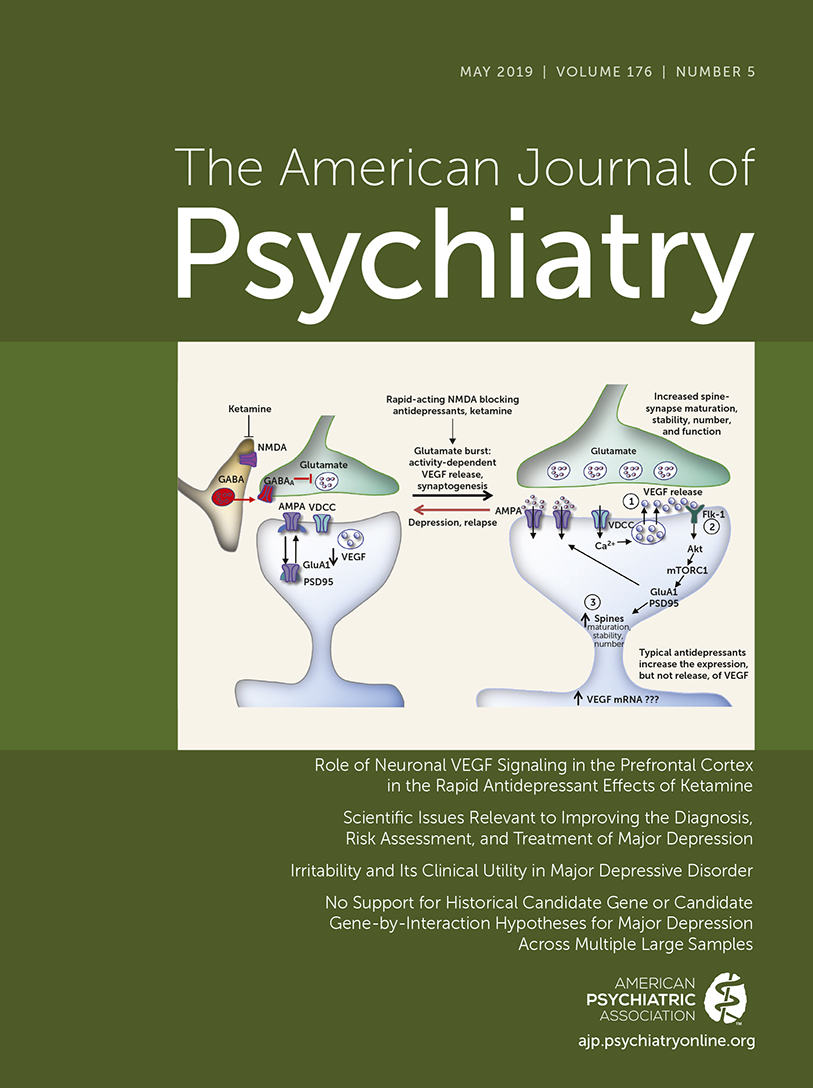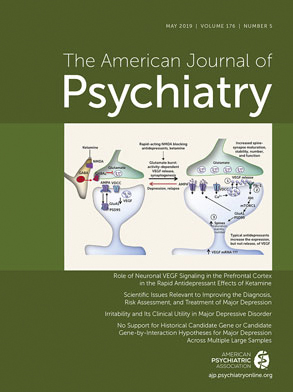Clinical heterogeneity thwarts efforts to understand the pathophysiology, course, and treatment of most, if not all, mental disorders. However, such effects create unique difficulties for research on major depressive disorder due to the high levels of clinical heterogeneity found in this condition. In this issue of the
Journal, Jha and colleagues (
1) address this problem by examining levels of irritability as a clinical moderator of treatment outcome. Among adults with major depressive disorder, the authors assessed irritability as a predictor of response to pharmacological treatment delivered within the context of a clinical trial. Jha and colleagues showed that changes in irritability occurring during the early phase of treatment predicted the later response of depressive symptoms to antidepressant medications. These findings suggest that elevated symptoms of irritability and their early change with treatment may help to identify a unique clinical subgroup of depressed adults, manifesting a distinct therapeutic profile.
Although such findings are clearly novel, other aspects of Jha and colleagues’ work are notable. For example, the authors grounded their analyses in “real-world” samples assessed with methods designed to directly inform clinical practice. They employed assessment techniques that require relatively little training to be used effectively by clinicians, and they used these techniques as part of a measurement-based care approach, which also can be readily taken up by clinicians actively delivering care. Moreover, the data were acquired in two large, independent cohorts. The methods in each cohort were similar enough to allow meaningful comparisons but different enough to provide insights on generalizability. The comparability of findings in the two cohorts further speaks to their importance. Finally, as with all outstanding pieces of clinical research, the observed associations substantially extend what we already know and raise many questions to pursue in future research.
While their work was with adults, Jha and colleagues note the developmental relevance of irritability. Indeed, research with children has generated novel insights concerning the importance of these new findings. The authors discuss age-related differences in nosology, in which the symptom of irritability is considered a core feature of major depressive disorder only in children and adolescents but not in adults. Their new findings raise questions on whether to include irritability as a feature of the diagnosis in all age groups.
Developmental research in relation to irritability extends beyond major depressive disorder, increasing exponentially over the past 20 years, following concerns that arose in the 1990s (
2). These concerns suggested that severe and chronic pediatric irritability might represent an expression of bipolar disorder. While raising initial caveats for clinicians, longitudinal and other research eventually revealed these concerns to be unfounded (
3,
4). Rather than any unique relation with bipolar disorder, this research suggests that severe and chronic pediatric irritability represents a distinct phenotype worthy of targeted investigation, independent of relationships with other clinical syndromes (
3–
5). Clearly, irritability in children and adolescents occurs in many clinical scenarios. Nevertheless, pediatric irritability predicts risk for bipolar disorder no more strongly than other pediatric emotional problems predict risk for bipolar disorder (
4).
Ongoing developmental research on irritability prioritizes attempts to improve measurement (
5), and the lessons learned in such work might inform attempts to extend findings reported by Jha and colleagues. Studies in children often rate patients’ levels of irritability using multiple informants while assessing broad ranges of behaviors. Future work in adults might consider the utility of similar approaches. As Jha and colleagues note, other clinical trials for major depressive disorder among adults target anger attacks (
6), but this clinical feature was not assessed in this new report, in which patients responded to five questions to rate perceptions of their irritable mood. Future studies might consider whether overt behaviors, including both anger attacks and argumentativeness, as well as patients’ own reports of their irritability, load onto a single underlying construct, reflecting core features of irritability. Such considerations might use multiple informants to evaluate this possibility.
Other research in children uses brain imaging to dissociate the underpinnings of irritability from related emotional problems. This includes depression, the focus in Jha and colleagues’ study (
1), as well as anxiety and overall levels of negative affectivity. Novel insights might emerge by extending such work to adults. For example, in children, the neural correlates of irritability differ from the correlates of anxiety and overall levels of negative affect (
7). Thus, future efforts in adults might attempt to dissect the shared and unique features that irritability exhibits when compared with other emotional problems.
One final interesting aspect of the study by Jha and colleagues concerns temporal features of the observed clinical response to antidepressants. The data here parallel findings in earlier work both in children and adults. As noted above, pediatric irritability occurs in many other childhood emotional problems, including anxiety. Anecdotal observations on temporal response features arose in early antidepressant trials for pediatric anxiety disorders (
8). These observations suggested that antidepressants’ markedly positive effects on pediatric anxiety occurred relatively late, after at least a few weeks of treatment. This contrasted with the positive effects on irritability, which appeared to occur within days. In other work, a different time course was observed for changes in symptoms of major depressive disorder compared with irritability. For example, in a clinical trial of fluoxetine treatment for premenstrual dysphoria (
9), irritability and associated mood symptoms responded within the first days of therapy. Therefore, there may be disorder-specific temporal profiles for the effects of antidepressants on irritability.
In the Jha and colleagues study, the temporal features of treatment-responsive irritability seemed to carve heterogeneous groups of adult patients with major depressive disorder. One group of patients exhibited a rapid reduction in irritability symptoms during the first month, and possibly even first days, of treatment. This group differed from other patients who exhibited no such marked, early improvements. When compared with these other patients, the presence of substantial early improvement in irritability predicted an approximate twofold greater likelihood of remission.
In closing, Jha and colleagues provide a rich foundation for understanding clinical heterogeneity in major depressive disorder, which carries important lessons for clinicians and researchers alike. They identify a unique subgroup of patients exhibiting a particularly beneficial response to antidepressants, thereby alerting clinicians to important, potentially overlooked features. Confidence on the importance of these observations follows from previous research, given that these new findings emerge against a wealth of comparable findings, particularly in child psychiatry and developmental psychology. Finally, their approach to research is grounded in a setting uniquely relevant to clinical practice, using approaches to measurement-based care that can be readily extended to the busy practice of the clinician. As such, these new findings speak equally profoundly to research and clinical communities.

